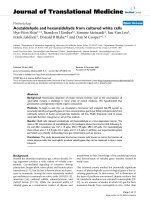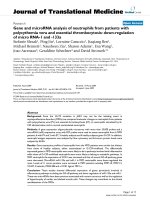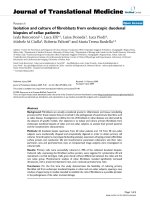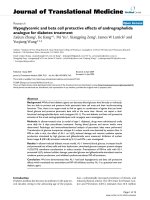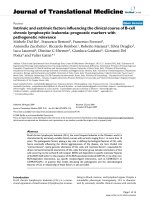Báo cáo hóa học: " Micrometer- and Nanometer-Sized Organic Single Crystalline Transisto" doc
Bạn đang xem bản rút gọn của tài liệu. Xem và tải ngay bản đầy đủ của tài liệu tại đây (177.23 KB, 2 trang )
NANO SPOTLIGHTS
Micrometer- and Nanometer-Sized Organic Single Crystalline
Transistors
Published online: 11 September 2008
Ó to the author 2008
Single crystal devices of organic semiconductors have
attracted worldwide attention due to (i) the high perfor-
mance of organic single crystalline devices and (ii) the
possibility of single crystals to reveal the intrinsic charge-
transport properties of organic semiconductors. Normally,
organic crystals exist as nanometer- or micrometer-sized
‘‘small’’ crystals because of the weak interaction between
the molecules of organic semiconductors, and it is chal-
lenging to grow large size organic single crystals for
devices, even the crystals at millimeter size. Hence, if
devices could be fabricated by using the ‘‘small’’ organic
crystals directly, it will be beneficial to not only keep all
the advantages of organic single crystals and avoid the
challenge for the growth of large-sized crystals, but also
provide a way to characterize organic semiconductors more
efficiently. Furthermore, the effective using of the ‘‘small’’
crystals will be meaningful for the integration of organic
single crystals to micro- and nanoelectronic devices.
Unfortunately, traditional inorganic microfabrication tech-
niques such as electro-beam/focused ion beam depositions
will damage or pollute organic crystals, which limit the
application of the inorganic microfabrication techniques
for organic single crystalline devices. So, new technologies
to fabricate devices with ‘‘small’’ organic crystals must be
developed. Recently, the researchers in Institute of
Chemistry, Chinese Academy of Science, explored several
One single micrometer-sized wire
was applied as the shadow mask. By
multi-movement of the micrometer-
sized wire, the channel length was
decreased and asymmetric electrode
devices could be fabricated.
A technique was developed
to make drain and source
electrodes with mechanical
process. Thin Au layers were
transferred onto the micro
/nanometer sized crystal as
electrodes.
Crystals were dispersed on
bottom-contact electrodes
via drop-casting, spin-
coating, or spraying
coating from the solution
with the suspension of
cr
y
stals.
Metal evaporation
Micrometer-sized wire
Gate
Dielectric
Gate
Dielectric
Gate
Dielectric
Asymmetric
electrodes
Symmetric
electrodes
Gate
Dielectric
Gate
Dielectric
Gate
Dielectric
Solution drops
with Suspension
Gate
Dielectric
Gate
Dielectric
A
B
C
Mechanical probe
of a probe ation
of crystals
123
Nanoscale Res Lett (2008) 3:395–396
DOI 10.1007/s11671-008-9157-x
novel methods to realize the fabrication of devices and
study the transport properties of the ‘‘small’’ crystals.
Prof. Wenping Hu and prof. Hongxiang Li, who lead the
research group from Beijing National Laboratory for
Molecular Science, Institute of Chemistry, Chinese Acad-
emy of Science, reported several novel methods to overcome
the challenge in Research News titled ‘‘Micrometer and
Nanometer-Sized Organic Single-Crystalline Transistors’’
in Advanced Materials published online on July 4, 2008.
‘‘By traditional physical vapor transport and chemical
solution growth process, micrometer and nanometer-sized
organic single crystals can be obtained more easily than
large-sized crystals. Using these micrometer- and nanome-
ter-sized organic single crystals not only retain all the merits
of single crystals, but also provide more effective ways to
characterize organic semiconductors,’’ said Hu and Li. ‘‘We
have opened up some new techniques to make small sized
organic single-crystalline devices, for example, the multi-
time gold microwire mask moving method.’’ Hu and Li
explained to Nanospotlight, ‘‘We placed the gold microwire
above the small crystals, fixed the gold wire with silver glue,
and then deposited the electrode. The gold wire serviced as
mask to obtain the conducting channel with the length equal
to the diameter of gold wire. After that, we slightly moved
the gold wire, and deposited the metal again. The channel
width can be decreased further. If a gold wire with width of
20 micrometer was used, the channel length can be
decreased till 5 micrometers.’’ ‘‘Another advantage of this
technique is the fabrication of the asymmetric electrodes,
which is difficult to realize by other mask technique.’’ With
this technique, high-performance copper phthalocyanine
(CuPc) devices with Au/Au symmetric electrodes (pub-
lished separately on November 21, 2005, online edition of
Advanced Materials, ‘‘Low threshold voltage transistors
based on individual single-crystalline submicrometer-sized
ribbons of copper phthalocyanine’’), and copper hexadeca-
fluoro phthalocyanine (F
16
CuPc) devices with Au/Ag
asymmetric electrodes (published separately in October 26,
2006, online edition of Journal of the American Chemical
Society, ‘‘High-Performance Air-Stable n-Type Transistors
with an Asymmetrical Device Configuration Based on
Organic Single-Crystalline Submicrometer/Nanometer
Ribbons’’) have been achieved. ‘‘We are also exploring
other device fabrication techniques.’’ Hu and Li said. ‘‘By
simply using a mechanical probe to scratch the polymer
layer on a Si substrate to create a gap as an air dielectric,
using single-crystalline ribbon as semiconductor layer, and
stamping the thin Au layers to form electrodes, the air-
dielectric devices could be fabricated.’’ The results achieved
by their group demonstrated excellent photo/air stability and
good performance of single-crystalline F
16
CuPc devices
(published separately on February 28, 2008, online edition
of Applied Physics Letters, ‘‘Air/vacuum Dielectric Organic
Single Crystalline Transistors of Copper-hexadecafluoro
phthalocyanine Ribbons’’). Another exciting result was the
ambipolar single-crystalline devices with the high mobilities
and good balanced carrier injection realized with this tech-
nique (published separately on April 1, 2008, online edition
of Advanced Materials, ‘‘High-Performance Air-Stable
Bipolar Field-Effect Transistors of Organic Single-Crystal-
line Ribbons with an Air-Gap Dielectric’’). ‘‘On the other
hand, the practical application requires the controlled
growth of these small crystals, which is also very chal-
lenging.’’ Hu and Li told Nanospotlight, ‘‘We developed a
seed-induced vapor growth process to obtain in situ pat-
terning of organic nanoribbons.’’ The compared results
proved that the clean environment of the physical transport
system and the high temperature of the substrate excluded
the possibility of interface contamination, and the in situ
patterned nanoribbons formed perfect interface with
dielectric (published separately on November 14, 2006,
online edition of Advanced Materials, ‘‘In Situ Patterning of
Organic Single-Crystalline Nanoribbons on a SiO
2
Surface
for the Fabrication of Various Architectures and High-
Quality Transistors’’). ‘‘Alternatively, we also explored the
growth of organic small crystals with chemical solution
method. Precise size-controlled crystals have been obtained
by carefully adjusting experimental parameters (published
separately on February 29, 2008, online edition of Journal of
the American Chemical Society, ‘‘Single-Crystalline, Size,
and Orientation Controllable Nanowires and Ultralong Mi-
crowires of Organic Semiconductor with Strong
Photoswitching Property’’).’’ Hu and Li said, ‘‘We are now
working to integrate these high-performance devices into
micro/nanoscale single-crystalline circuits. The experi-
mental results have showed that the complex circuits can be
constructed with these micro/nanocrystals.’’
Kimberly Annosha Sablon
396 Nanoscale Res Lett (2008) 3:395–396
123



